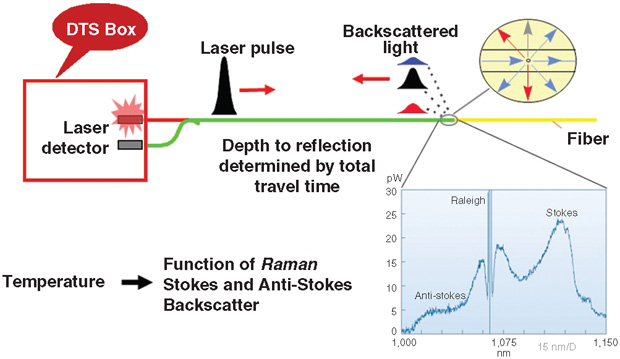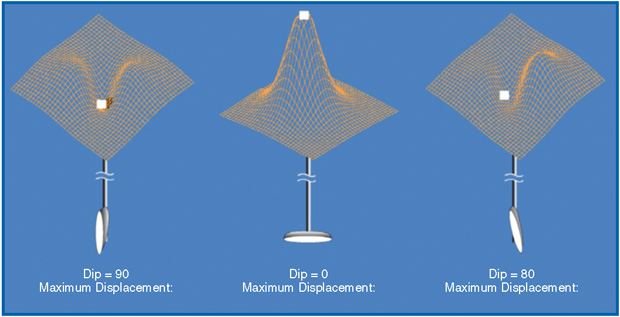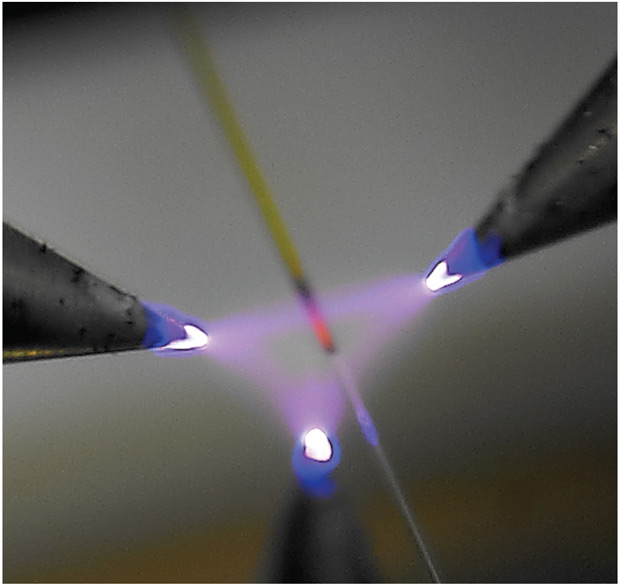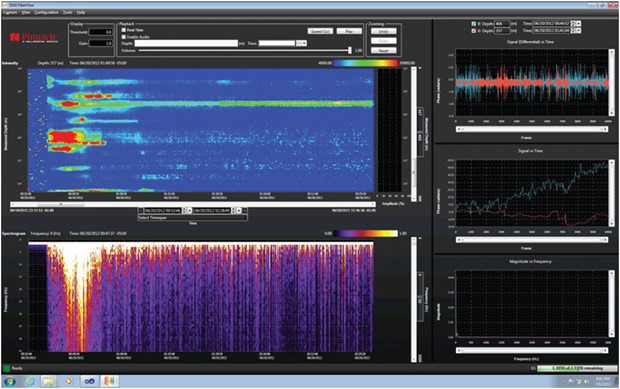
Fiber Optic Sensors Creating New Possibilities For Optimizing Fracturing
By Glenn R. McColpin
HOUSTON–The United States ranked number one in the world for both crude oil and natural gas production growth last year, and U.S. producers appear to be positioned to defend that title in 2013 and well beyond. As unlikely at it may have seemed only five years ago, the nation has turned around its energy destiny completely, all thanks to unconventional resource plays.
A litany of sophisticated technologies are being deployed in even the most “routine” shale gas and tight oil development projects, but if operators could point to a single technology that has enabled the domestic industry’s rise to global champion of oil and gas production growth it surely would be hydraulic fracturing. Simply put, the ability to economically and safely induce fractures in ultratight hydrocarbon-bearing rock has revolutionized oil and gas development and opened new horizons of recoverable resources, beginning in dry gas shales and migrating into a range of tight liquids formations.
Although hydraulic fracturing has been around for 70 years, large-scale operations have come into their own only over the past decade. Accordingly, hydraulic fracturing still is a relatively new and evolving technology, particularly in regard to analyzing and controlling fractures in real time as they propagate in long horizontal laterals.
Over the past few years, a few visionary operators have been evaluating a completely new hydraulic fracturing diagnostic technique: distributed fiber optic sensing.
Unlike conventional reservoir monitoring devices, in which the sensing element is a physical device usually placed at the end of a copper line, with distributed fiber optic sensing, the entire length of glass fiber is turned into thousands of sensing points. This is accomplished by firing a pulse of laser light down the fiber and analyzing the signals that are reflected back from various spots in the fiber.
A distributed temperature sensing (DTS) system consisting of a surface unit using a laser and photo detector is shown in Figure 1. The fiber line represents the downhole system component in oil and gas wells.
Successfully exploiting reservoirs in which permeability is measured in microDarcies requires optimally creating multiple hydraulic fractures along the well bore to deliver oil and gas production rates that can be sustained at profitable levels during the entire production phase. Moreover, because completion is typically the largest single cost component in unconventional plays, balancing capital expenditures associated with hydraulic fracturing against the resulting production benefits is crucial to economics in these plays.
Unfortunately, high-quality subsurface data that can be used to optimize fracture strategies are often lacking in unconventional field developments. The result is significant reservoir and well bore performance uncertainties that can negatively impact asset performance.
Frac optimization initially focused on fluid chemistry and proppant selection, and then transitioned to evaluating the effect of volumes and rates on hydrocarbon recovery factors. The largest treatments today use several million gallons of fluid and millions of pounds of proppant.
Moving beyond merely watching surface pressure responses to estimate subsurface fracturing activity, operators first began deploying diagnostic such as tiltmeters to obtain a better view of what was happening in the formation.
Figure 2 shows mathematical models that demonstrate the expected surface deformations with vertical, horizontal and dipping fractures, illustrating characteristic surface deformation features with different fracture orientations at reservoir depth.
A critical advance has been microseismic monitoring, which provides an even better subsurface picture of fracture growth and effectiveness, but it still leaves operators with multiple possible interpretations of the results and performance inconsistencies from one stage to another, leading to such questions as: Why is there microseismic overlap? Is there stage communication in the reservoir? Is a plug leaking or is there poor cement quality in that particular hole section?
Fiber Optic Sensing
With distributed fiber optic sensing, by analyzing the laser light reflections from different spots in the fiber, the temperature and strain of the glass can be determined at any point in the well, and the fiber can be turned into a series of distributed microphones or hydrophones.
Fiber optic technologies came out of military and space research and development programs. While DTS has been around for some time, until recently, glass chemistry and laser interrogation hardware have not been at a level of robustness where systems could survive in downhole environments for long periods. Distributed acoustic sensing (DAS) is an even more recent technological development.
Because of its physical properties, glass can thrive as a sensor at extremely high temperatures and efficiently transmit large quantities of data. Figure 3 shows polyimide-coated fiber being stripped before splicing using a plasma stripping machine operating at 1,300 degrees Celsius (2,370 degrees Fahrenheit). Whereas in the past, one may have been limited to a couple of sensing points per well, with distributed sensing, the operator effectively has thousands of measurement points covering the entire well bore.
Spatial resolution is usually on the order of one to two meters. This high sample density allows the distributed fiber optic sensing technology to illuminate activities that were never before possible. By installing distributed sensors behind casing, the industry now has a reliable and cost-effective method to perform life-of-well monitoring. From cementing to stimulation, to production and ultimately to plugging and abandonment, every phase of a well’s life can be monitored in high resolution.
For the large unconventional reservoirs that operators are now targeting, the real value of distributed fiber optic sensing comes in combining multiple subsurface diagnostic techniques with the surface hardware and fluid chemistry to get the most out of each fracturing treatment. In a project where thousands of wells may be drilled, it is critical to get the well spacing and horizontal orientation correct. If the operator does not have it right, he is either drilling too few wells and stranding valuable reserves, or drilling too many wells spaced too closely together and wasting tens of millions of dollars on drilling and completing wells that are not required.
Far-field monitoring techniques such as tiltmeters and microseismic provide a picture of how each stage is progressing away from the well bore. Job parameters can be modified on the fly in an attempt to control the subsurface results. By combining the new near-well-bore imaging that fiber optic sensing provides with legacy far-field techniques, it becomes possible to track fluid and proppant from the time it enters the wellhead to when it exits the perforations and is placed in the formation.
Optimization Step Change
Instead of focusing on optimization at the stage level, the increased granularity that fiber optic sensing brings allows treatments to be optimized at individual perforation clusters or sleeves. With DTS and DAS, operators can actually “see” and “hear” where fluid and proppant are moving along each individual meter of the well. By being prepared on location with physical or chemical diverters, a frac job can be optimized on the fly at the perforation cluster level by monitoring where rock is not being stimulated, and controlling where the fluid and proppant are needed to meet the design criteria.
This ability to control which clusters are taking fluid in a single stage in real time is a step change in optimization. In the past, operators mapped where the frac went in the far-field and only had the ability to control rates and chemistry, if reality did not match predictions and models. Today, the industry has a comprehensive tool kit that allows operators to control the frac in real time, and to ensure that each cluster and stage is treated as uniformly as possible. Uniform treatments will result in uniform half lengths and optimized well spacing.
Although this is a brand new technique, multiple datasets have indicated that users can watch downhole operations with a level of detail never thought possible, and can control where fluid is leaving the casing.
With distributed fiber optic sensing providing the ability to both see and hear what is happening in the subsurface as it happens, more often than not, events can be identified that may have a profound impact on stimulation efficiency. Some examples are poor zonal isolation, failed equipment, fluid temperatures outside design envelopes, minimal cluster efficiency, and reservoir cross-flow. All these things have been occurring, but a tool has never before been available to allow operators to watch well bore operations at such a precise level of detail.
With sliding sleeve completion hardware, the user actually can track each ball as it travels down the pipe and watch it bounce through multiple sleeves until it seats in the designed location. The fiber optic interpreter on location becomes a critical part of the frac crew and can provide critical insights on when a ball is in the right location to increase pump pressure to open the correct sleeve. No longer will a frac job accidently open the wrong sleeve and leave all the experts on site looking at a surface pressure gauge trying to diagnose what just happened 10,000 feet down the vertical section and out into the lateral. Figure 4 displays real-time diagnostic software showing DAS acoustic amplitude (top) and frequency content (bottom) data.
Some mechanical failures, even though evident through monitoring with fiber optics, may not be fixed economically in real time. Being aware of issues is important so that the industry can build a proper understanding of what constitutes a truly successful hydraulic fracturing and completion design. Some of the repeatedly identified problems are starting to drive longer-term engineering design changes with equipment manufacturers.
These lessons learned also are helping the industry further calibrate frac models by allowing users to model the impact of treatment inefficiencies. This information can be used in reservoir simulators to understand the impact on stranded reserves and overall drainage efficiency. Refrac candidates for a well can be quantified and their economic viability determined.
Life-Of-Well Value
While distributed fiber optic systems are invaluable in monitoring hydraulic fracture treatments, they also provide value throughout the life of a well. During cementing operations, plugs can be tracked and their locations verified. Fluid levels can be monitored along with cement cure temperatures to adjust cement wait times. After the frac job, the same distributed sensing fiber can be used to perform production logging or be used for long-term well bore integrity monitoring. In-well equipment can be monitored to optimize production and verify proper operation.
Looking ahead, these systems are starting to be used for vertical seismic profiling without running expensive wireline-deployed tools, and companies are evaluating whether the fiber can be used for other forms of seismic or microseismic monitoring. Figure 5 shows VSP data collected on a single DAS fiber optic line sensor.
When a new technology comes out, an “upgrade” can be performed by simply swapping surface hardware. There is no need to pull a completion or live with what was placed in a well originally. DAS data are being collected on wells where fiber was installed years before DAS systems were commercial.
The term “big data” is used to describe large and complex datasets. In the context of monitoring and controlling hydraulic fracturing, it is defined by the three Vs: velocity, variety and volume. DAS systems have the ability to fill a DVD with data every 30 seconds. Collecting 15 terrabytes of data on a week-long frac job is typical, with raw data processing creating audio, video and derivative data files. While the industry already is seeing huge benefits in the qualitative analysis resulting from looking at well site DTS and DAS data streams, we are merely scratching the surface.
Embedded in the distributed sensing data are layers upon layers of information that the industry is only now starting to get its head around. Some of the value will be unlocked only when operators are able to cross-correlate these data with databases containing well bore, treatment, reservoir and seismic information and models. Applying data analytics and parallel computing on a large scale is going to be the key to fully exploiting these strange, but exciting new diagnostic tools.

GLENN R. MCCOLPIN is director of reservoir monitoring for Halliburton’s Pinnacle service line. He is responsible for developing and implementing near-well-bore and far-field diagnostic solutions for reservoir surveillance and stimulation optimization, ranging from fiber optic sensing to microseismic and ground- or satellite-based microdeformation monitoring. McColpin started his career in nuclear logging and directional drilling with Sperry Sun Drilling Services. He spent 12 years with Landmark Graphics in various management roles, including product development, sales and consulting. At Pinnacle, McColpin served as vice president of sales and marketing before taking on the challenge of building a world-class fiber optic sensing business. He also is on the board of Prime Photonics, a fiber optical sensing company specializing in solutions for harsh environments. McColpin previously served on the boards of Yates Petroleum and Agave Energy. He holds three U.S. patents and earned a degree in petroleum engineering from the New Mexico Institute of Mining and Technology.
For other great articles about exploration, drilling, completions and production, subscribe to The American Oil & Gas Reporter and bookmark www.aogr.com.



















